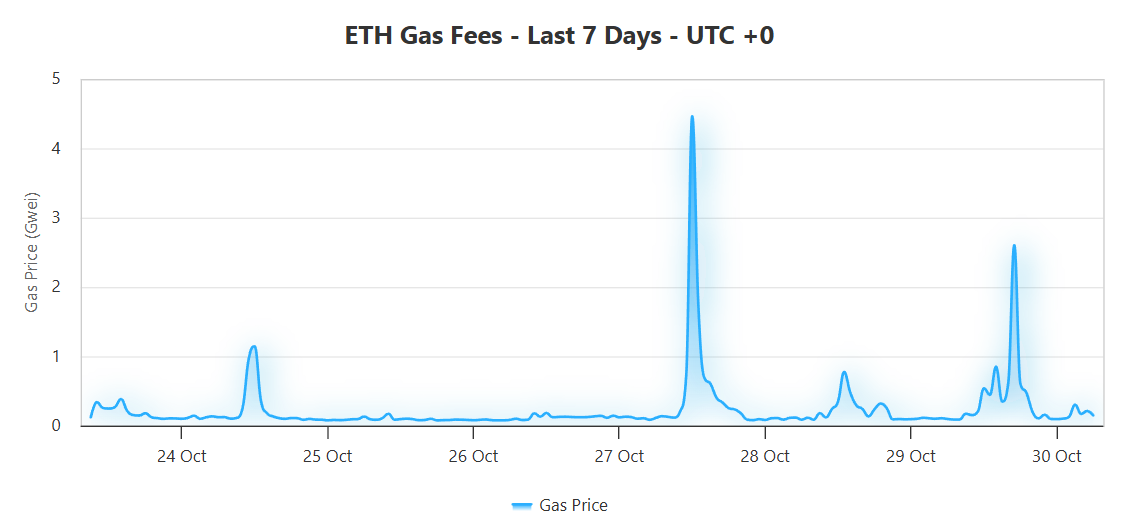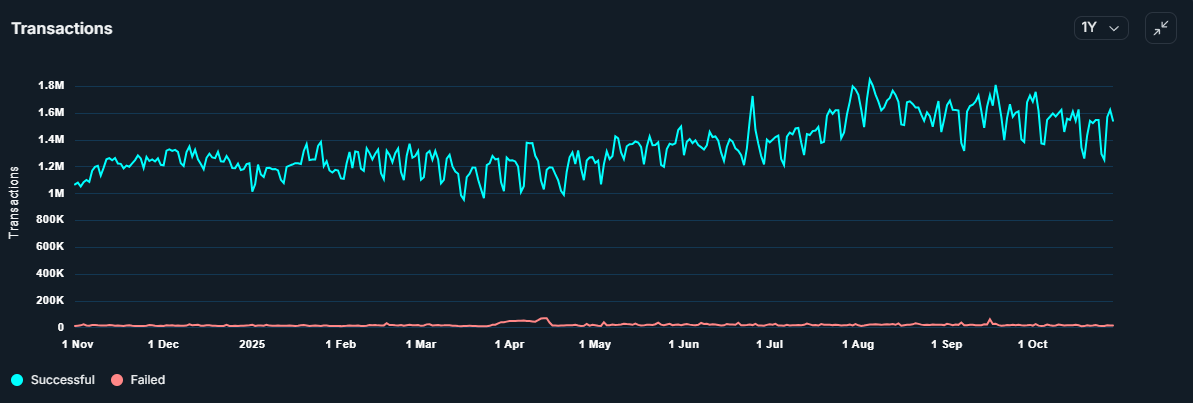Ethereum transaction fees are at historic lows of about $0.01 per transaction, even as daily network activity surges past 1.6 million transactions. This resilience stems from recent upgrades like Dencun and Pectra, enhancing scalability and reducing costs for users engaging in smart contracts, token swaps, and NFTs.
-
Ethereum’s gas fees hit 0.16 gwei amid rising activity, contrasting past fee spikes during high demand.
-
Network transactions reached 1.6 million daily, a one-month high not seen since early October.
-
Active addresses peaked at 695,872, supported by upgrades that cut L2 fees by 50% and mainnet costs by 95%.
Ethereum transaction fees stay low at $0.01 despite 1.6M daily transactions—discover how Dencun and Pectra upgrades boost scalability. Explore implications for crypto users and investors today.
What Are Ethereum Transaction Fees and Why Are They So Low Now?
Ethereum transaction fees, often called gas fees, are the costs users pay to execute operations on the Ethereum blockchain, such as transferring tokens or interacting with smart contracts. Currently, these fees remain at historic lows of around 0.16 gwei, equating to roughly $0.01 per basic transaction, despite a surge in network activity. This stability highlights Ethereum’s improved infrastructure, making it more accessible for everyday use without the prohibitive costs seen in previous bull markets.
Ethereum transaction fees remain at near all-time lows despite peak network activity that saw daily transactions top 1.6 million for the first time since October’s market crash.
Despite growing blockchain activity on Ethereum, gas fees on the world’s largest smart contract network remain near historic lows, signaling a more mature and scalable infrastructure ready for advanced real-world use cases.
Ethereum transaction fees remained at a historic low of just 0.16 gwei, or about $0.01 per transaction. Gas fees were slightly higher for token swaps at $0.15 and at $0.27 for non-fungible token (NFT) sales, according to blockchain data aggregator Milkroad.
The low costs stand in sharp contrast to previous periods of high network activity, when demand often sent fees soaring, which was one of Ethereum’s biggest criticisms in past cycles.

Ethereum gas fees, 1-month chart. Source: milkroad.com/ethereum
Related: ‘No BlackRock, no party’ for Bitcoin, altcoin ETF investments: K33 Research
How Has Ethereum’s Network Activity Increased Without Raising Fees?
Ethereum’s network has seen a notable uptick in usage, with daily transactions climbing to 1.6 million on a recent Tuesday, approaching levels last observed at the start of October before significant market volatility. This increase reflects growing adoption of decentralized applications (dApps), DeFi protocols, and NFT marketplaces, all powered by Ethereum’s robust ecosystem. Active addresses followed suit, hitting a monthly peak of 695,872 on a Saturday, as reported by crypto intelligence platform Nansen. What makes this surge remarkable is the absence of fee inflation; instead, costs have stabilized due to strategic protocol enhancements.
Blockchain analysts attribute this balance to Ethereum’s ongoing evolution toward greater efficiency. For instance, the average transaction volume has not only recovered from earlier downturns but also diversified across layers, reducing congestion on the mainnet. Data from on-chain metrics shows that while Layer 1 (L1) activity remains steady, much of the load has shifted to Layer 2 (L2) solutions like Optimism and Arbitrum, which process transactions off-chain before settling on Ethereum. This offloading mechanism ensures that even as overall activity rises, individual users experience minimal cost barriers.
Experts in the field, such as those from Ethereum Foundation researchers, emphasize that these trends indicate a maturing network capable of handling real-world scale. “The combination of increased throughput and subdued fees positions Ethereum as a leader in blockchain scalability,” noted a senior developer in a recent industry panel discussion. Supporting statistics reveal that L2 transaction volumes have grown by over 40% in the past quarter, further alleviating pressure on the base layer and keeping fees in check.
Ethereum activity rises amid stable fees
Daily transactions on the network rose to 1.6 million on Tuesday, marking a near one-month high, last seen at the beginning of October before the record $19 billion liquidation event.

Ethereum total transactions, 1-year chart. Source: app.Nansen.ai
Active addresses also rose to similar values, peaking at a monthly high of 695,872 on Saturday, according to crypto intelligence platform Nansen.
Related: Saylor’s Strategy tipped for S&P 500 inclusion after Q3 earnings: 10X Research
Frequently Asked Questions
What Impact Have Ethereum Upgrades Had on Transaction Fees?
Ethereum’s Dencun upgrade, deployed on March 13, 2024, and the subsequent Pectra upgrade in May have dramatically lowered transaction fees. Dencun reduced L2 costs by introducing data blobs, cutting mainnet fees by 95%, while Pectra doubled blob capacity, slashing L2 fees by about 50%. These changes enable more efficient data handling, allowing the network to process higher volumes without fee spikes, benefiting developers and users alike.
How Do Low Ethereum Transaction Fees Affect DeFi and NFT Users?
Low Ethereum transaction fees make DeFi platforms and NFT trading more accessible by reducing the cost of frequent interactions, like lending, borrowing, or minting assets. For example, a simple token swap now costs just $0.15, compared to dollars in past peaks. This affordability encourages broader participation, fostering innovation in decentralized finance and digital collectibles while maintaining Ethereum’s position as the go-to smart contract platform.
Ethereum’s historically low gas fees follow the Dencun and Pectra upgrades, both designed to lower transaction costs and expand throughput.
Deployed in May, the Pectra upgrade has doubled the blob capacity of layer-2 (L2) networks, cutting the transaction fees on L2s by around 50%. This upgrade also served to offload more transactions from the mainnet to further cut costs.
Ethereum’s previous major upgrade, Dencun, has also managed to cut L2 transaction fees and offload more transactions from the L1, making average Ethereum transaction fees cheaper by 95% a year after it was deployed on March 13, 2024, Cointelegraph reported.
Magazine: Back to Ethereum — How Synthetix, Ronin and Celo saw the light
Key Takeaways
- Historic Low Fees: Ethereum transaction fees at $0.01 signal improved scalability, contrasting past volatility and enabling cost-effective dApp usage.
- Surge in Activity: Over 1.6 million daily transactions and 695,000 active addresses show robust adoption without network strain, thanks to L2 integrations.
- Upgrade Benefits: Dencun and Pectra have reduced costs by up to 95%, positioning Ethereum for mainstream applications—consider exploring L2 solutions for your next project.
Conclusion
In summary, Ethereum transaction fees’ persistence at near all-time lows amid rising network activity underscores the blockchain’s advancements through upgrades like Dencun and Pectra. These developments not only address long-standing scalability challenges but also enhance Ethereum’s role in DeFi, NFTs, and beyond. As activity continues to grow, users and developers can anticipate even more efficient, affordable interactions, paving the way for widespread blockchain adoption in the coming years.
